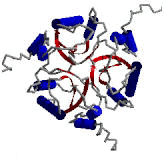Screens save protein-profile time

Looks don’t matter: new techniques find enzymes like this one by function not form
Two new techniques will assist the rapid cataloguing of proteins’ roles in the cell.
Decoding the human genome sequence was merely a preliminary step towards understanding how living cells work. Two new techniques should assist the next step: working out the functions of all the proteins that the genes encode1,2.
Selectively sticking to small molecules is central to most proteins’ function. Proteins generally have delicately sculpted binding sites, clefts into which certain target molecules, called substrates, fit like a key in a lock. Often this binding allows the protein to act as a catalyst, chemically transforming the substrate.
The functional role of a particular protein is therefore revealed, or at least hinted at, by what it binds. Two teams have now identified the substrates of a range of proteins.
Current methods for assigning a function to a protein rely on a detailed knowledge of its structure or shape. Proteins are long chains of interlinked amino acids, folded up into a compact shape. If two proteins have very similar amino-acid sequences, they probably share similar functions.
Deducing the sequences of each of the many thousands of proteins in a cell is a slow business. Another approach is to use X-ray crystallography to determine the protein’s three-dimensional shape – where each atom sits.
Researchers are now trying to develop automated systems for the rapid crystallographic study of many proteins3. Unfortunately, some proteins share a similar function even if they look different, as long as their binding sites fit similar substrates.
So Gerhard Klebe and colleagues at the University of Marburg in Germany have compared the binding sites of various proteins and evaluated the similarity of their substrates – regardless of any differences either in sequence or overall protein shape. In other words, the method spots commonalities hidden from existing techniques.
The researchers compared the binding sites of two enzymes, one from yeast and one from Escherichia coli bacteria. Because the enzymes share the same function even though only 20% of their amino-acid sequences overlap, a sequence comparison would not recognize that they do the same job. But the computer program identified the E. coli enzyme as the closest match to the yeast enzyme from 5,445 other protein binding sites.
Spotting relationships such as this could also aid drug design by suggesting new small molecules that might block the activity of certain enzymes.
Meanwhile, Peter Schultz and co-workers at the Scripps Research Institute in La Jolla, California, have developed a way to screen huge numbers of proteins simultaneously and pick out those that bind to particular target molecules.
The researchers have taken the complex protein mixture that every cell contains and presented it with small substrates tagged with strands of PNA, a molecule similar to DNA and capable of binding to it. The PNA acts as a kind of label: its chemical structure is like a bar code for the attached substrate.
When a protein latches onto the substrate, the PNA latches onto a strand of DNA at a particular location on a grid-like array. The PNA-DNA pairing glows, lighting up a grid point on the array and signalling the presence of the substrate-binding protein.
References
- Schmitt, S., Hendlich, M. & Klebe, G. From structure to function: a new approach to detect functional similarity among proteins independent from sequence and fold homology. Angewandte Chemie, 40, 3141 – 3144, (2001).
- Winssinger, N., Harris, J. L., Backes, B. J. & Schultz, P. G. From split-pool libraries to spatially addressable microarrays and its application to functional proteomic profiling. Angewandte Chemie, 40, 3152 – 3155, (2001).
- Abola, E., Kuhn, P., Earnest, T. & Stevens, R. C. Automation of X-ray crystallography. Nature Structural Biology, 7, 973 – 977, (2001).
Media Contact
All latest news from the category: Life Sciences and Chemistry
Articles and reports from the Life Sciences and chemistry area deal with applied and basic research into modern biology, chemistry and human medicine.
Valuable information can be found on a range of life sciences fields including bacteriology, biochemistry, bionics, bioinformatics, biophysics, biotechnology, genetics, geobotany, human biology, marine biology, microbiology, molecular biology, cellular biology, zoology, bioinorganic chemistry, microchemistry and environmental chemistry.
Newest articles

First-of-its-kind study uses remote sensing to monitor plastic debris in rivers and lakes
Remote sensing creates a cost-effective solution to monitoring plastic pollution. A first-of-its-kind study from researchers at the University of Minnesota Twin Cities shows how remote sensing can help monitor and…

Laser-based artificial neuron mimics nerve cell functions at lightning speed
With a processing speed a billion times faster than nature, chip-based laser neuron could help advance AI tasks such as pattern recognition and sequence prediction. Researchers have developed a laser-based…

Optimising the processing of plastic waste
Just one look in the yellow bin reveals a colourful jumble of different types of plastic. However, the purer and more uniform plastic waste is, the easier it is to…



